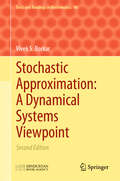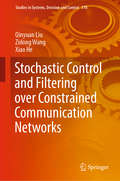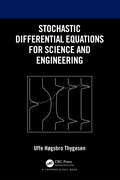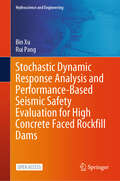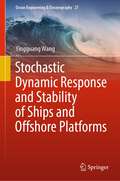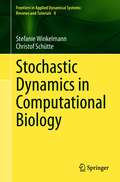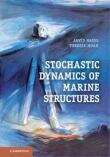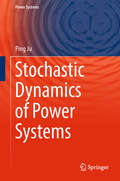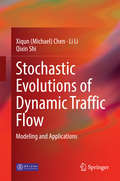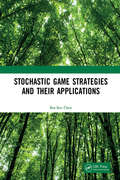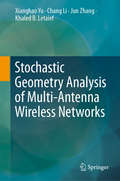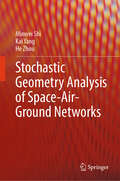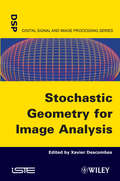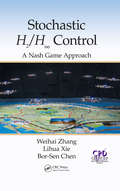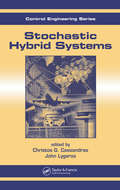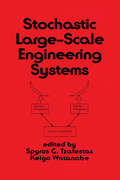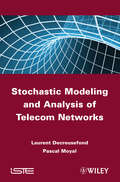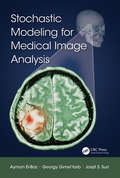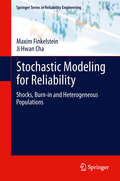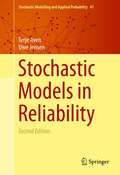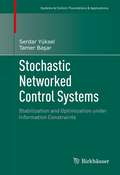- Table View
- List View
Stochastic Approximation: Second Edition (Texts and Readings in Mathematics #48)
by Vivek S. BorkarThis book serves as an advanced text for a graduate course on stochastic algorithms for graduate students in probability and statistics, engineering, economics and machine learning. This second edition gives a comprehensive treatment of stochastic approximation algorithms based on the “ordinary differential equation (ODE) approach” which analyses the algorithm in terms of a limiting ODE. It has a streamlined treatment of the classical convergence analysis and includes several recent developments such as concentration bounds, avoidance of traps, stability tests, distributed and asynchronous schemes, multiple time scales, general noise models, etc., and a category-wise exposition of many important applications. It is also a useful reference for researchers and practitioners in the field.
Stochastic Averaging and Stochastic Extremum Seeking
by Shu-Jun Liu Miroslav KrsticStochastic Averaging and Extremum Seeking treats methods inspired by attempts to understand the seemingly non-mathematical question of bacterial chemotaxis and their application in other environments. The text presents significant generalizations on existing stochastic averaging theory developed from scratch and necessitated by the need to avoid violation of previous theoretical assumptions by algorithms which are otherwise effective in treating these systems. Coverage is given to four main topics. Stochastic averaging theorems are developed for the analysis of continuous-time nonlinear systems with random forcing, removing prior restrictions on nonlinearity growth and on the finiteness of the time interval. The new stochastic averaging theorems are usable not only as approximation tools but also for providing stability guarantees. Stochastic extremum-seeking algorithms are introduced for optimization of systems without available models. Both gradient- and Newton-based algorithms are presented, offering the user the choice between the simplicity of implementation (gradient) and the ability to achieve a known, arbitrary convergence rate (Newton). The design of algorithms for non-cooperative/adversarial games is described. The analysis of their convergence to Nash equilibria is provided. The algorithms are illustrated on models of economic competition and on problems of the deployment of teams of robotic vehicles. Bacterial locomotion, such as chemotaxis in E. coli, is explored with the aim of identifying two simple feedback laws for climbing nutrient gradients. Stochastic extremum seeking is shown to be a biologically-plausible interpretation for chemotaxis. For the same chemotaxis-inspired stochastic feedback laws, the book also provides a detailed analysis of convergence for models of nonholonomic robotic vehicles operating in GPS-denied environments. The book contains block diagrams and several simulation examples, including examples arising from bacterial locomotion, multi-agent robotic systems, and economic market models. Stochastic Averaging and Extremum Seeking will be informative for control engineers from backgrounds in electrical, mechanical, chemical and aerospace engineering and to applied mathematicians. Economics researchers, biologists, biophysicists and roboticists will find the applications examples instructive.
Stochastic Control and Filtering over Constrained Communication Networks (Studies in Systems, Decision and Control #178)
by Zidong Wang Qinyuan Liu Xiao HeStochastic Control and Filtering over Constrained Communication Networks presents up-to-date research developments and novel methodologies on stochastic control and filtering for networked systems under constrained communication networks. It provides a framework of optimal controller/filter design, resilient filter design, stability and performance analysis for the systems considered, subject to various kinds of communication constraints, including signal-to-noise constraints, bandwidth constraints, and packet drops. Several techniques are employed to develop the controllers and filters desired, including:recursive Riccati equations;matrix decomposition;optimal estimation theory; andmathematical optimization methods.Readers will benefit from the book’s new concepts, models and methodologies that have practical significance in control engineering and signal processing. Stochastic Control and Filtering over Constrained Communication Networks is a practical research reference for engineers dealing with networked control and filtering problems. It is also of interest to academics and students working in control and communication networks.
Stochastic Cooling of Particle Beams
by Dieter MöhlThis lecture note describes the main analytical approaches to stochastic cooling. The first is the time domain picture, in which the beam is rapidly sampled and a statistical analysis is used to describe the cooling behaviour. The second is the frequency domain picture, which is particularly useful since the observations made on the beam are mainly in this domain. This second picture is developed in detail to assess key components of modern cooling theory like mixing and signal shielding and to illustrate some of the diagnostic methods. Finally the use of a distribution function and the Fokker-Plank equation, which offer the most complete description of the beam during the cooling, are discussed.
Stochastic Differential Equations for Science and Engineering
by Uffe Høgsbro ThygesenStochastic Differential Equations for Science and Engineering is aimed at students at the M.Sc. and PhD level. The book describes the mathematical construction of stochastic differential equations with a level of detail suitable to the audience, while also discussing applications to estimation, stability analysis, and control. The book includes numerous examples and challenging exercises. Computational aspects are central to the approach taken in the book, so the text is accompanied by a repository on GitHub containing a toolbox in R which implements algorithms described in the book, code that regenerates all figures, and solutions to exercises. Features: Contains numerous exercises, examples, and applications Suitable for science and engineering students at Master’s or PhD level Thorough treatment of the mathematical theory combined with an accessible treatment of motivating examples GitHub repository available at: https://github.com/Uffe-H-Thygesen/SDEbook and https://github.com/Uffe-H-Thygesen/SDEtools
Stochastic Dynamic Response Analysis and Performance-Based Seismic Safety Evaluation for High Concrete Faced Rockfill Dams (Hydroscience and Engineering)
by Bin Xu Rui PangThis open access book provides a complete probabilistic analysis method and a performance-based seismic safety evaluation for high concrete faced rockfill dam (CFRD). Combined with random sample generation and reliability analysis methods, the dynamic response characteristics and reliability level of CFRD under various random factors are comprehensively described. In Chapter 2, a random ground motion model based on spectral representation-random function and a high-dimensional random variable generation method based on GF- discrepancy are established. Combined with probability density evolution method (PDEM) and the random sample generation methods to verify its effectiveness and reliability for nonlinear complex geotechnical engineering. In Chapter 3, the dynamic response and probabilistic characteristics of high CFRD under random ground motion are revealed based on the elastoplastic analysis. A performance-based seismic safety evaluation method is established. In Chapter 4, the influence of material parameter randomness on dynamic response and seismic safety of high CFRD is studied from the perspective of stochastic dynamics and probability. In Chapter 5, the stochastic dynamic response and probability distribution of high CFRD under the coupled random action of ground motion and material parameters are systematically studied, and the performance-based seismic safety evaluation framework is improved. In Chapter 6, The stochastic dynamic response of 3D high CFRD is studied, and the failure performance index and performance level based on overstress volume ratio combined with overstress accumulation time are discussed. The performance-based seismic safety evaluation framework is further improved. In Chapter 7, combined with the finite element dynamic time-history analysis method considering the softening effect of rockfill, a performance-based seismic safety evaluation framework for dam slope stability of high CFRD under multiple random factors is systematically explored from the perspective of stochastic dynamics and probability. In Chapter 8, The performance indexes of seismic safety evaluation for high CFRDs are suggested and the corresponding performance level with probability assurance is put forward. The multi-seismic intensity - multi-performance target - failure probability performance relationship is established, and a performance-based seismic safety evaluation framework is initially formed. This book can be used as a reference for scholars studying random vibration and reliability analysis, as well as for scholars studying dam safety evaluation.
Stochastic Dynamic Response and Stability of Ships and Offshore Platforms (Ocean Engineering & Oceanography #27)
by Yingguang WangThis textbook investigates in detail the methods for stochastic dynamic response and stability analyses of nonlinear systems (especially ships and ocean engineering systems), elucidating the advantages and disadvantages of each of the methods (the statistical linearization method, the perturbation method, the Monte Carlo Simulation method, the numerical path integration method, the global geometric method and the first passage theory). Studies on stochastic dynamic analysis of nonlinear systems have attracted engineers and scientists from various disciplines, such as aeronautical, civil, mechanical and ocean engineering. Pursuing a systematic approach, this book establishes a fundamental framework for this topic, while emphasizing the importance of accurate and efficient analysis as well as the significant influence of choosing a suitable method in the design and optimization of various nonlinear engineering systems (especially ships and ocean engineering systems).The textbook is intended for upper undergraduate and graduate students who are interested in advanced dynamic analysis technologies, researchers investigating nonlinear systems under stochastic dynamic excitations, and civil/mechanical/structural/ocean engineers working on designing and optimization of real-world nonlinear engineering systems. The basis of English translation of this book from its Chinese original manuscript was done with the help of artificial intelligence. A subsequent human revision of the content was done by the author.
Stochastic Dynamics in Computational Biology (Frontiers in Applied Dynamical Systems: Reviews and Tutorials #8)
by Stefanie Winkelmann Christof SchütteThe aim of this book is to provide a well-structured and coherent overview of existing mathematical modeling approaches for biochemical reaction systems, investigating relations between both the conventional models and several types of deterministic-stochastic hybrid model recombinations. Another main objective is to illustrate and compare diverse numerical simulation schemes and their computational effort. Unlike related works, this book presents a broad scope in its applications, from offering a detailed introduction to hybrid approaches for the case of multiple population scales to discussing the setting of time-scale separation resulting from widely varying firing rates of reaction channels. Additionally, it also addresses modeling approaches for non well-mixed reaction-diffusion dynamics, including deterministic and stochastic PDEs and spatiotemporal master equations. Finally, by translating and incorporating complex theory to a level accessible to non-mathematicians, this book effectively bridges the gap between mathematical research in computational biology and its practical use in biological, biochemical, and biomedical systems.
Stochastic Dynamics of Marine Structures
by Arvid Naess Torgeir MoanStochastic Dynamics of Marine Structures is a text for students and reference for professionals on the basic theory and methods used for stochastic modeling and analysis of marine structures subjected to environmental loads. The first part of the book provides a detailed introduction to the basic dynamic analysis of structures, which serves as a foundation for later chapters on stochastic response analysis. This includes an extensive chapter on the finite element method. A careful introduction to stochastic modeling is provided, which includes the concepts: stochastic process, variance spectrum, random environmental processes, response spectrum, response statistics, and short- and long-term extreme value models. The second part of the book offers detailed discussions of limit state design approaches, fatigue design methods, the equations of motion for dynamic structures, and numerical solution techniques. The final chapter highlights methods for prediction of extreme values from measured data or data obtained by Monte Carlo simulation.
Stochastic Dynamics of Power Systems (Power Systems)
by Ping JuThis book discusses stochastic dynamics of power systems and the related analytical methodology. It summarizes and categorizes the stochastic elements of power systems and develops a framework for research on stochastic dynamics of power systems. It also establishes a research model for stochastic dynamics of power systems and theoretically proves stochastic stability in power systems. Further, in addition to demonstrating the stochastic oscillation mechanism in power systems, it also proposes methods for quantitative analysis and stochastic optimum control in the field of stochastic dynamic security in power systems. This book is a valuable resource for researchers, scholars and engineers in the field of electrics.
Stochastic Evolutions of Dynamic Traffic Flow
by Li Li Xiqun Michael Chen Qixin ShiThis book reveals the underlying mechanisms of complexity and stochastic evolutions of traffic flows. Using Eulerian and Lagrangian measurements, the authors propose lognormal headway/spacing/velocity distributions and subsequently develop a Markov car-following model to describe drivers' random choices concerning headways/spacings, putting forward a stochastic fundamental diagram model for wide scattering flow-density points. In the context of highway onramp bottlenecks, the authors present a traffic flow breakdown probability model and spatial-temporal queuing model to improve the stability and reliability of road traffic flows. This book is intended for researchers and graduate students in the fields of transportation engineering and civil engineering.
Stochastic Game Strategies and their Applications
by Bor-Sen ChenGame theory involves multi-person decision making and differential dynamic game theory has been widely applied to n-person decision making problems, which are stimulated by a vast number of applications. This book addresses the gap to discuss general stochastic n-person noncooperative and cooperative game theory with wide applications to control systems, signal processing systems, communication systems, managements, financial systems, and biological systems. H∞ game strategy, n-person cooperative and noncooperative game strategy are discussed for linear and nonlinear stochastic systems along with some computational algorithms developed to efficiently solve these game strategies.
Stochastic Geometry Analysis of Cellular Networks
by Martin Haenggi Bartłomiej Błaszczyszyn Paul Keeler Sayandev MukherjeeAchieve faster and more efficient network design and optimization with this comprehensive guide. Some of the most prominent researchers in the field explain the very latest analytic techniques and results from stochastic geometry for modeling the signal-to-interference-plus-noise ratio (SINR) distribution in heterogeneous cellular networks. This book will help you understand the effects of combining different system deployment parameters on such key performance indicators as coverage and capacity, enabling efficient allocation of simulation resources. In addition to covering results for network models based on the Poisson point process, this book presents recent results for when non-Poisson base station configurations appear Poisson due to random propagation effects such as fading and shadowing, as well as non-Poisson models for base station configurations, with a focus on determinantal point processes and tractable approximation methods. Theoretical results are illustrated with practical long-term evolution (LTE) applications and compared with real-world deployment results.
Stochastic Geometry Analysis of Multi-Antenna Wireless Networks
by Jun Zhang Xianghao Yu Chang Li Khaled B. LetaiefThis book presents a unified framework for the tractable analysis of large-scale, multi-antenna wireless networks using stochastic geometry. This mathematical analysis is essential for assessing and understanding the performance of complicated multi-antenna networks, which are one of the foundations of 5G and beyond networks to meet the ever-increasing demands for network capacity. Describing the salient properties of the framework, which makes the analysis of multi-antenna networks comparable to that of their single-antenna counterparts, the book discusses effective design approaches that do not require complex system-level simulations. It also includes various application examples with different multi-antenna network models to illustrate the framework’s effectiveness.
Stochastic Geometry Analysis of Space-Air-Ground Networks
by Kai Yang Minwei Shi He ZhouThis book presents a comprehensive framework for the theoretical analysis of space-air-ground networks using stochastic geometry. This analytical approach is indispensable for evaluating the performance of large-scale space-air-ground networks, which serve as critical facilitators for the advancement of the sixth-generation wireless communication aimed at providing high-speed broadband coverage for remote areas. By incorporating the features of topology and channel model in different tiers, this book investigates the key performance metrics in terms of load balancing, coverage assessment, and mobility management. The developed mechanisms provide effective design insights for space-air-ground networks while obviating the need for complex system-level simulations.
Stochastic Geometry for Image Analysis (Wiley-iste Ser.)
by Xavier DescombesThis book develops the stochastic geometry framework for image analysis purpose. Two main frameworks are described: marked point process and random closed sets models. We derive the main issues for defining an appropriate model. The algorithms for sampling and optimizing the models as well as for estimating parameters are reviewed. Numerous applications, covering remote sensing images, biological and medical imaging, are detailed. This book provides all the necessary tools for developing an image analysis application based on modern stochastic modeling.
Stochastic H2/H ∞ Control: A Nash Game Approach
by Lihua Xie Weihai Zhang Bor-Sen ChenThe H∞ control has been one of the important robust control approaches since the 1980s. This book extends the area to nonlinear stochastic H2/H∞ control, and studies more complex and practically useful mixed H2/H∞ controller synthesis rather than the pure H∞ control. Different from the commonly used convex optimization method, this book applies the Nash game approach to give necessary and sufficient conditions for the existence and uniqueness of the mixed H2/H∞ control. Researchers will benefit from our detailed exposition of the stochastic mixed H2/H∞ control theory, while practitioners can apply our efficient algorithms to address their practical problems.
Stochastic Hybrid Systems (Automation and Control Engineering)
by Christos G. Cassandras John LygerosBecause they incorporate both time- and event-driven dynamics, stochastic hybrid systems (SHS) have become ubiquitous in a variety of fields, from mathematical finance to biological processes to communication networks to engineering. Comprehensively integrating numerous cutting-edge studies, Stochastic Hybrid Systems presents a captivating treatment of some of the most ambitious types of dynamic systems.Cohesively edited by leading experts in the field, the book introduces the theoretical basics, computational methods, and applications of SHS. It first discusses the underlying principles behind SHS and the main design limitations of SHS. Building on these fundamentals, the authoritative contributors present methods for computer calculations that apply SHS analysis and synthesis techniques in practice. The book concludes with examples of systems encountered in a wide range of application areas, including molecular biology, communication networks, and air traffic management. It also explains how to resolve practical problems associated with these systems. Stochastic Hybrid Systems achieves an ideal balance between a theoretical treatment of SHS and practical considerations. The book skillfully explores the interaction of physical processes with computerized equipment in an uncertain environment, enabling a better understanding of sophisticated as well as everyday devices and processes.
Stochastic Large-Scale Engineering Systems
by Spyros G. TzafestasThis book focuses on the class of large-scale stochastic systems, which has dominated the attention of many academic and research groups. It discusses distributed-sensor networks, decentralized detection theory, and econometric models with integrated and decentralized policymakers.
Stochastic Modeling and Analysis of Telecom Networks
by Pascal Moyal Laurent DecreusefondThis book addresses the stochastic modeling of telecommunication networks, introducing the main mathematical tools for that purpose, such as Markov processes, real and spatial point processes and stochastic recursions, and presenting a wide list of results on stability, performances and comparison of systems. The authors propose a comprehensive mathematical construction of the foundations of stochastic network theory: Markov chains, continuous time Markov chains are extensively studied using an original martingale-based approach. A complete presentation of stochastic recursions from an ergodic theoretical perspective is also provided, as well as spatial point processes. Using these basic tools, stability criteria, performance measures and comparison principles are obtained for a wide class of models, from the canonical M/M/1 and G/G/1 queues to more sophisticated systems, including the current “hot topics” of spatial radio networking, OFDMA and real-time networks. Contents 1. Introduction. Part 1: Discrete-time Modeling 2. Stochastic Recursive Sequences. 3. Markov Chains. 4. Stationary Queues. 5. The M/GI/1 Queue. Part 2: Continuous-time Modeling 6. Poisson Process. 7. Markov Process. 8. Systems with Delay. 9. Loss Systems. Part 3: Spatial Modeling 10. Spatial Point Processes.
Stochastic Modeling for Medical Image Analysis
by Ayman El-Baz Georgy Gimel’farb Jasjit S. SuriStochastic Modeling for Medical Image Analysis provides a brief introduction to medical imaging, stochastic modeling, and model-guided image analysis.Today, image-guided computer-assisted diagnostics (CAD) faces two basic challenging problems. The first is the computationally feasible and accurate modeling of images from different modalities to obt
Stochastic Modeling for Reliability
by Maxim Finkelstein Ji Hwan ChaFocusing on shocks modeling, burn-in and heterogeneous populations, Stochastic Modeling for Reliability naturally combines these three topics in the unified stochastic framework and presents numerous practical examples that illustrate recent theoretical findings of the authors. The populations of manufactured items in industry are usually heterogeneous. However, the conventional reliability analysis is performed under the implicit assumption of homogeneity, which can result in distortion of the corresponding reliability indices and various misconceptions. Stochastic Modeling for Reliability fills this gap and presents the basics and further developments of reliability theory for heterogeneous populations. Specifically, the authors consider burn-in as a method of elimination of 'weak' items from heterogeneous populations. The real life objects are operating in a changing environment. One of the ways to model an impact of this environment is via the external shocks occurring in accordance with some stochastic point processes. The basic theory for Poisson shock processes is developed and also shocks as a method of burn-in and of the environmental stress screening for manufactured items are considered. Stochastic Modeling for Reliability introduces and explores the concept of burn-in in heterogeneous populations and its recent development, providing a sound reference for reliability engineers, applied mathematicians, product managers and manufacturers alike.
Stochastic Models for Prices Dynamics in Energy and Commodity Markets: An Infinite-Dimensional Perspective (Springer Finance)
by Fred Espen Benth Paul KrühnerThis monograph presents a theory for random field models in time and space, viewed as stochastic processes with values in a Hilbert space, to model the stochastic dynamics of forward and futures prices in energy, power, and commodity markets. In this book, the well-known Heath–Jarrow–Morton approach from interest rate theory is adopted and extended into an infinite-dimensional framework, allowing for flexible modeling of price stochasticity across time and along the term structure curve. Various models are introduced based on stochastic partial differential equations with infinite-dimensional Lévy processes as noise drivers, emphasizing random fields described by low-dimensional parametric covariance functions instead of classical high-dimensional factor models. The Filipović space, a separable Hilbert space of Sobolev type, is found to be a convenient state space for the dynamics of forward and futures term structures. The monograph provides a classification of important operators in this space, covering covariance operators and the stochastic modeling of volatility term structures, including the Samuelson effect. Fourier methods are employed to price many derivatives of interest in energy, power, and commodity markets, and sensitivity 'delta' expressions can be derived. Additionally, the monograph covers forward curve smoothing, the connection between forwards with fixed delivery and delivery period, as well as the classical theory of forward and futures pricing. This monograph will appeal to researchers and graduate students interested in mathematical finance and stochastic analysis applied in the challenging markets of energy, power, and commodities. Practitioners seeking sophisticated yet flexible and analytically tractable risk models will also find it valuable.
Stochastic Models in Reliability
by Terje Aven Uwe JensenThis book provides a comprehensive up-to-date presentation of some of the classical areas of reliability, based on a more advanced probabilistic framework using the modern theory of stochastic processes. This framework allows analysts to formulate general failure models, establish formulae for computing various performance measures, as well as determine how to identify optimal replacement policies in complex situations. In this second edition of the book, two major topics have been added to the original version: copula models which are used to study the effect of structural dependencies on the system reliability; and maintenance optimization which highlights delay time models under safety constraints. Terje Aven is Professor of Reliability and Risk Analysis at University of Stavanger, Norway. Uwe Jensen is working as a Professor at the Institute of Applied Mathematics and Statistics of the University of Hohenheim in Stuttgart, Germany. Review of first edition: "This is an excellent book on mathematical, statistical and stochastic models in reliability. The authors have done an excellent job of unifying some of the stochastic models in reliability. The book is a good reference book but may not be suitable as a textbook for students in professional fields such as engineering. This book may be used for graduate level seminar courses for students who have had at least the first course in stochastic processes and some knowledge of reliability mathematics. It should be a good reference book for researchers in reliability mathematics." --Mathematical Reviews (2000)
Stochastic Networked Control Systems
by Tamer Başar Serdar YükselNetworked control systems are increasingly ubiquitous today, with applications ranging from vehicle communication and adaptive power grids to space exploration and economics. The optimal design of such systems presents major challenges, requiring tools from various disciplines within applied mathematics such as decentralized control, stochastic control, information theory, and quantization. A thorough, self-contained book, Stochastic Networked Control Systems: Stabilization and Optimization under Information Constraints aims to connect these diverse disciplines with precision and rigor, while conveying design guidelines to controller architects. Unique in the literature, it lays a comprehensive theoretical foundation for the study of networked control systems, and introduces an array of concrete tools for work in the field. Salient features included: · Characterization, comparison and optimal design of information structures in static and dynamic teams. Operational, structural and topological properties of information structures in optimal decision making, with a systematic program for generating optimal encoding and control policies. The notion of signaling, and its utilization in stabilization and optimization of decentralized control systems. · Presentation of mathematical methods for stochastic stability of networked control systems using random-time, state-dependent drift conditions and martingale methods. · Characterization and study of information channels leading to various forms of stochastic stability such as stationarity, ergodicity, and quadratic stability; and connections with information and quantization theories. Analysis of various classes of centralized and decentralized control systems. · Jointly optimal design of encoding and control policies over various information channels and under general optimization criteria, including a detailed coverage of linear-quadratic-Gaussian models. · Decentralized agreement and dynamic optimization under information constraints. This monograph is geared toward a broad audience of academic and industrial researchers interested in control theory, information theory, optimization, economics, and applied mathematics. It could likewise serve as a supplemental graduate text. The reader is expected to have some familiarity with linear systems, stochastic processes, and Markov chains, but the necessary background can also be acquired in part through the four appendices included at the end. · Characterization, comparison and optimal design of information structures in static and dynamic teams. Operational, structural and topological properties of information structures in optimal decision making, with a systematic program for generating optimal encoding and control policies. The notion of signaling, and its utilization in stabilization and optimization of decentralized control systems. · Presentation of mathematical methods for stochastic stability of networked control systems using random-time, state-dependent drift conditions and martingale methods. · Characterization and study of information channels leading to various forms of stochastic stability such as stationarity, ergodicity, and quadratic stability; and connections with information and quantization theories. Analysis of various classes of centralized and decentralized control systems. · Jointly optimal design of encoding and control policies over various information channels and under general optimization criteria, including a detailed coverage of linear-quadratic-Gaussian models. · Decentralized agreement and dynamic optimization under information constraints. This monograph is geared toward a broad audience of academic and industrial researchers interested in control theory, information theory, optimization, economics, and applied mathematics. It could likewise serve as a supplemental graduate text. The reader is expected to have some familiarity with linear systems, stochastic processes, and Markov chai...
